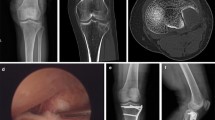Abstract
Background
Schatzker type V and VI tibial fractures are complex injuries, usually treated with open reduction and internal fixation (ORIF) using dual plates or ring fixators. ORIF has the advantage of not requiring pin tract care, but has a higher infection rate, especially in open fractures. We have combined the advantages of these two methods to treat these difficult fractures.
Materials and Methods
Ten Schatzker type V and 11 Schatzker type VI fractures were treated between 2006 and 2010. ORIF with dual plates was performed, only if there was marked articular displacement (> 2 mm) in a closed fracture. All other fractures including open fractures and closed fractures with soft tissue compromise or minimal articular displacement were treated with ring fixators. The outcomes were analyzed and documented using the Honkonen and Jarvinen subjective, clinical, functional, and radiological criteria and the Western Ontario and McM aster Universities Arthritis Index (WOMAC).
Results
Nine closed fractures with marked articular displacement (> 2 mm) were treated with dual plates. Eight closed fractures with minimal articular displacement (< 2 mm) and poor skin condition and four open fractures were treated with ring fixators. The mean follow-up period was 2 ½ years. The mean postoperative knee flexion was 128°. All patients could walk, jump, and climb steps. 90% could squat, though only 50% could duck walk properly. Radiologically, 85% had a plateau tilt of less than 5°, 92% had an articular step of less than 2 mm, and a residual articular widening of less than 5 mm. There were no major infections. Two patients had minor pin tract infections and two requested that their plates be removed subsequently.
Conclusion
The protocol used to treat Schatzker type V and VI tibial plateau fractures has had excellent results and we suggest that all open fractures be treated with ring fixators and that ORIF should be done only for closed fractures with marked displacement.
Similar content being viewed by others
References
Mckee MD, Pirani SP, Stephen DJ. The Canadian Orthopedic Trauma Society, Open reduction and internal fixation compared with circular fixator application for bicondylar tibial plateau fractures. Results of a multicenter, prospective, randomized clinical trial. J Bone Joint Surg Am 2006;88:2613–23.
Young MJ, Barrack RL. Complications of internal fixation of tibial plateau fractures. Orthop Rev 1994;23:149–54.
Moore TM, Patzakis MJ, Harvey JP. Tibial plateau fractures: Definition, demographics, treatment rationale and long-term results of closed traction management or operative reduction. J Orthop Trauma 1987;1:97–119.
Mallik AR, Covall DJ, Whitelaw GP. Internal versus external fixation of bicondylar tibial plateau fractures. Orthop Rev 1992;21:1433–6.
Lasanianos NG, Garnavos C, Magnisalis E, Kourkoulis S, Babis GC. A comparative biomechanical study for complex tibial plateau fractures: Nailing and compression bolts versus modern and traditional plating. Injury 2013;44:1333–9.
Barei DP, Nork SE, Mills WJ, Henley B, Benirschke SK. Complications associated with internal fixation of high-energy bicondylar tibial plateau fractures utilizing a two incision technique. J Orthop Trauma 2004;18:649–57.
Honkonen SE, Jarvinen MJ. Classification of fractures of the tibial condyles. J Bone Joint Surg Br 1992;74:840–7.
Bellamy N, Buchanan WW, Goldsmith CH, Campbell J, Stitt LW. Validation study of WOMAC: A health status instrument for measuring clinically important patient relevant outcomes to antirheumatic drug therapy in patients with osteoarthritis of the hip or knee. J Rheumatol 1988;15:1833–40.
Uhl RL, Goldstock L, Carter AT, Lozman J. Hybrid external fixation for bicondylar tibial plateau fractures. Presented at the 61st AAOS meeting, New Orleans, Louisiana, 1994.
Kataria H, Sharma N, Kanojia RK. Small wire external fixation for high-energy tibial plateau fractures. J Orthop Surg (Hong Kong) 2007;15:137–43.
Subasi M, Kapukaya A, Arslan H, Ozkul E, Cebesoy O. Outcome of open comminuted tibial plateau fractures treated using an external fixator. J Orthop Sci 2007;12:347–53.
Buckle R, Blake R, Watson JT, Morandi M, Browner BD. Treatment of the complex tibial plateau fractures with the Ilizarov external fixator. J Orthop Trauma 1993;7:167–8.
Author information
Authors and Affiliations
Corresponding author
Rights and permissions
About this article
Cite this article
Pun, T.B., Krishnamoorthy, V.P., Poonnoose, P.M. et al. Outcome of Schatzker type V and VI tibial plateau fractures. IJOO 48, 35–41 (2014). https://doi.org/10.4103/0019-5413.125490
Published:
Issue Date:
DOI: https://doi.org/10.4103/0019-5413.125490




